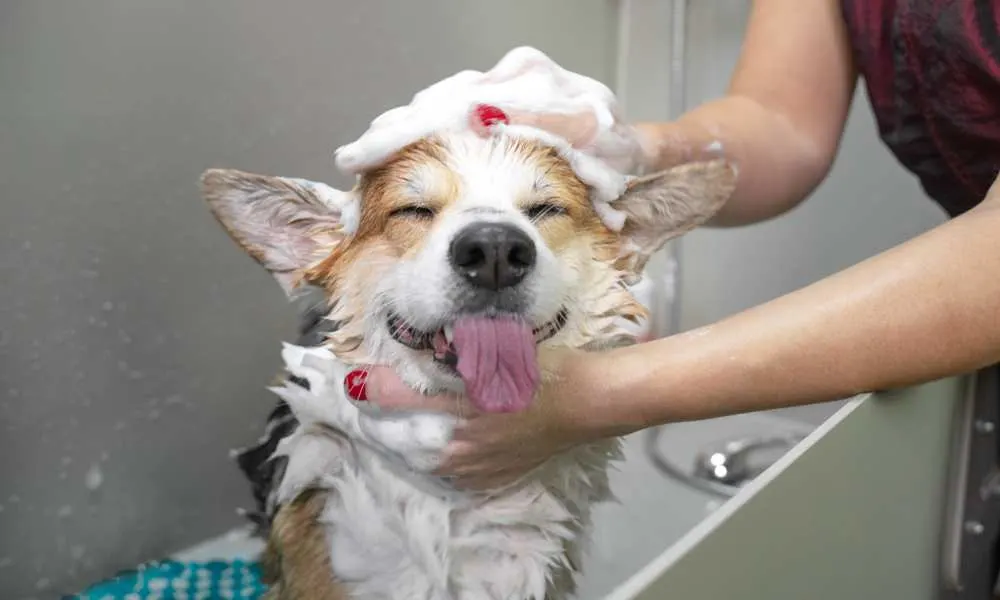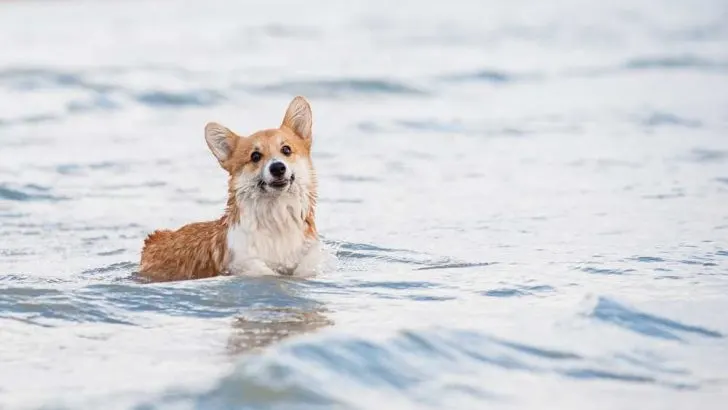Have you ever stopped for a second and asked yourself – why does my corgi float in water when we go swimming? If you have, we’ve got the answer!
The corgi breed is a fascinating one. These dogs can do almost anything. They can go hiking, take care of livestock, even go for a swim in the lake with you. But when it comes to swimming, there is something unusual going on. If you look closely, you can see that your corgi is floating. Wait, why do corgis float in water? Well, that’s because their bodies are built in a specific way, but we’ll get to that.
So, if you’re wondering why your corgi is suddenly floating while you are swimming next to him, scroll down and find out!

The Floating Corgi – Myth or Reality?
Why do corgis float?
No kidding, your corgi CAN actually float in water. If you’re someone who takes their dog on adventures, you must have seen this. For a non-believer, this might sound impossible and made-up, but it’s true.
Your corgi’s floating ability comes from the shape of its body. How exactly?
Well, it’s all thanks to their soft and fluffy buttocks. Corgi’s butts, unlike the rest of their body, contain almost 80% air, so you can imagine why it ends up on the surface.
This unusual “bodyweight” earned them the nickname – bubble butt.
So, the next time you take your corgi out for a swim, take a good look at what stays underwater and what floats to the surface.
Wait A Second, Do Corgis Even Like Water?
When it comes to their ability to swim, like any other breed, corgis are no exception. Even if they have been a stranger to the water, once you throw them in, you can be sure they’ll manage quickly. So, that’s not the issue.
The issue is whether they enjoy being in the water in the first place.
Well, this is a tough one. Corgis are naturally herding dogs, which makes them excellent on land, but how do they manage underwater?
Being in the water is not exactly an ideal environment for a corgi. Don’t get me wrong – no dog is excited when it comes to bathing.
Corgis are not necessarily a fan of swimming. The question is – can you get them to like water?
It is different for every corgi, and it depends on how you trained them. If your corgi hasn’t been exposed to water most of its life, and now you suddenly want to make them swim – it won’t look good.
The key is to get them used to water being an integral part of their lives. This means that you have to start early while they are still puppies. You can start by taking them down to the beach for a walk.
If you have a big yard and you use sprinklers, you can use them to your advantage and turn them on during summer – your corgi will enjoy a bit of refreshment.
What To Do If My Corgi Is Scared Of Water?
Bear in mind that this is not unusual at all. Some dogs have a massive fear of water, and you should take this seriously. However, they still need to be around water – bathing.
So, how to get over this problem? The key is not to push your corgi too hard and too fast. If you see that your corgi is repulsive towards the water, have patience. Baby steps!
Don’t do irrational things like spraying it intentionally or throwing it in the tub. This will only provoke aggressive behavior, and you don’t want that.
Be mindful and respective of your corgi’s preference towards the water, and if things work out the way they should – you will see them floating next to you in the pool.
Take a look at this adorable video of a corgi swimming:

Shower Schedule
Dog hygiene involves a regular bathing schedule – giving your dog an excellent, thorough bath. But, every breed differs, and bathing schedules are not the same for everyone.
How many times your dog needs to be bathed depends on several factors. They include:
- Hair length
- Activity level
- Skin sensitivity
Okay, let’s explain this.
Hair Length
Some dogs have a thick coat, and others have a thin one. This is actually the factor that influences and determines the frequency of bathing.
Logically, breeds with a thick coat attract more dust, bacteria, and dirt on their coat. This means that the time between their baths is tight. Corgis fall into this category with their double coats.
Activity Level
There’s a difference when it comes to the activity level of your dog. For example, dogs who are not so active and spend most of their time indoors, logically, are not prone to dirt and everything that comes with running around in the backyard.
On the other hand, if your dog is the adventurous type, you might be looking for more frequent showers. If you’re an owner of a corgi, baths become more frequent as they grow up.
Skin Sensitivity
Lastly, we have skin sensitivity. Not all breeds can bear the sometimes strong composition of dog shampoos. Dog breeds with sensitive coats and those that are prone to skin infections should not be bathed that often, or the owner must carefully choose the shampoos.
Although corgis have a double coat, it is still sensitive, and if you have dealt with some infections during the time it was still a puppy, it would be best to visit the vet and ask for some recommendations.
THE BOTTOM LINE: The average shower schedule for your corgi would be once or twice in a month. Senior corgis that have retired from their adventures can be showered once in three months.
Useful Tips
Surely you could use a couple of useful tips regarding your dog’s bathing time. If you’re looking for a wholesome and helpful bathing routine, don’t forget the following:
1. Shampoo and Additional Supplies
Dog shampoo isn’t the only thing you need. Of course, it’s the most important, but you could use some sponges and shower sticks to better wash out that shampoo. The choice is also important – be careful when shopping for shampoos. Some are composed of extremely strong chemicals that could provoke inflammations.
2. Brush it out
After you have bathed your dog and maybe even blow-dried their coat, pick up a brush and go through it a couple of times. A thorough and careful brush through their coat helps them get rid of possible tangles and excess hair – and there is undoubtedly some of it.
3. Temperature matters
You should be aware that every dog is unique, and not all of them like a flaming hot bath. Some dogs prefer cold water. However, it would be best if you didn’t rely on these extremes – they can be harmful to your dog. Try to find the middle that works for both of you.
4. Blow dryers speed up things
After finishing the hard part, it’s time to dry that coat. Doing it the old-fashioned way and using a towel can be energy-draining and time-consuming. Why not speed up things and include a blow dryer? You can set the heat level, and your dog’s coat can be dry in just a couple of minutes.
5. Patience is key
It might be a challenge getting your dog into the tub. Like we said earlier, not all breeds are comfortable with being surrounded by water. So, when the time for a bath comes, make sure that your dog is comfortable with being in the tub. Take it slow, and try to lure it in the bathroom.
Bathing can be a fun and easy experience, just take a look at this video:

Tiny Legs – Corgi’s Main Obstacle
For more than 300 years, short legs in corgis have been their most recognizable feature. Here’s an interesting fact about this: corgis were bred purposely to have short legs.
Why?
Since these dogs were in charge of looking after livestock, farmers bred these dogs so that they have short legs that would protect them from being a target.
However, in the past, corgis were not so short. These dogs used to have longer legs. Today, only the Australian Cattle Dog that has partial corgi genes is gifted with long legs.
Although this served as a huge advantage when it came to farming, these short legs ended up being an obstacle in other spheres in life.
This is where swimming comes in. This is just one of many activities that are a challenge for this breed because of their miniature paws and legs.
In order to keep swimming, a dog has to have strong legs and developed muscles. For a corgi dog, this is a bit harder. Although these dogs can walk the walk, it can be harder to keep on swimming.
This phenomenon of having short legs leads us to the term – achondroplastic dwarfism.
What is this exactly?
This is a “defect” that occurs in several breeds, such as the corgi breed and the dachshund. You can notice that both of these breeds have extremely short legs.
This is actually controlled by a specific gene – FGF4. This is a fibroblast growth factor 4 that influences the development of limbs in dogs.
So, if your corgi is not an excellent swimmer, it’s not because you didn’t teach them well. This is a genetic issue.

Swimming Vests – Yes Or No?
When it comes to corgis, dog swimming vests are an absolute YES. This invention makes your corgi’s swimming easier, and it can save a life.
When choosing a life jacket for your corgi, there are 3 factors you need to consider:
- THE HANDLE: Look for a life jacket that has a handle on it. If you are an owner who likes to take his corgi to adventures in some “stormy waters,” having a handle you can grab in a matter of seconds is a lifesaver.
- D-RING: A high-quality dog life jacket will have a D-ring. You can attach a leash to this, so you don’t have to take the jacket off when you come out of the water. You can just add the leash to it.
- COLOR: Choosing a life swimming vest that is covered in bright colors (a flashy green or yellow) is an excellent idea because it will be ten times easier to spot your dog if he swims away from you at one moment.
If you’re really interested in buying one of these, here are some recommendations:
- “Outward Hound Granby Dog Life Jacket” – equipped with handles
- “Kimol Shark Fin Dog Life Jacket” – has reflective buckle straps
- “Vivaglory Dog Life Jacket” – available in all sizes (from XS to XL)
- “Hurtta Dog Life Savior Jacket” – contains reflectors on the backside


